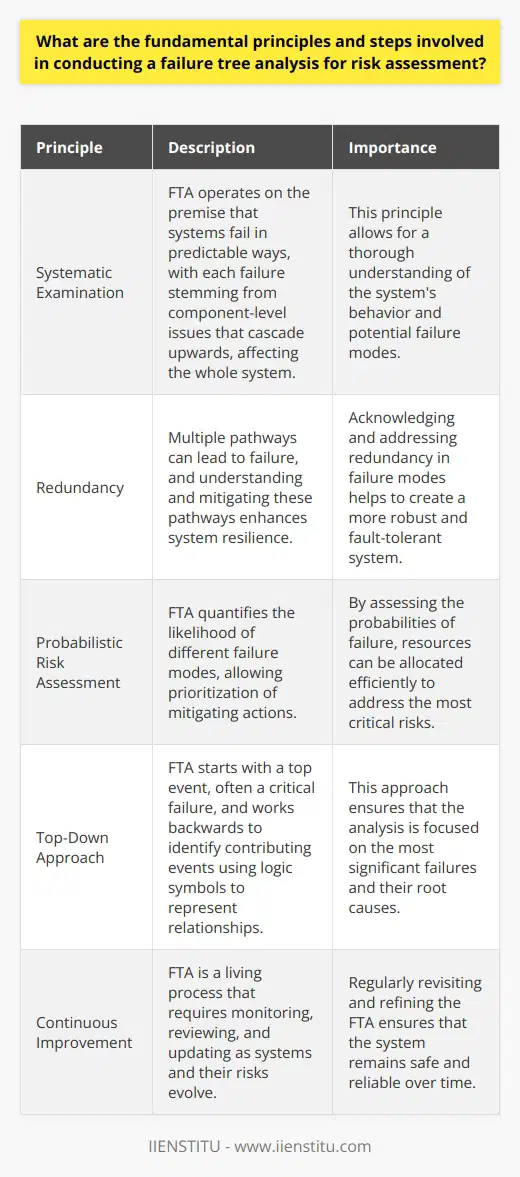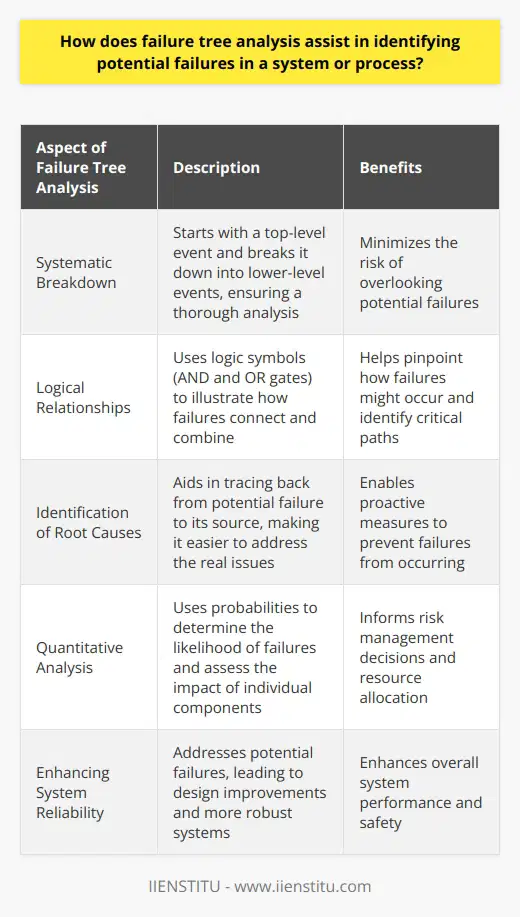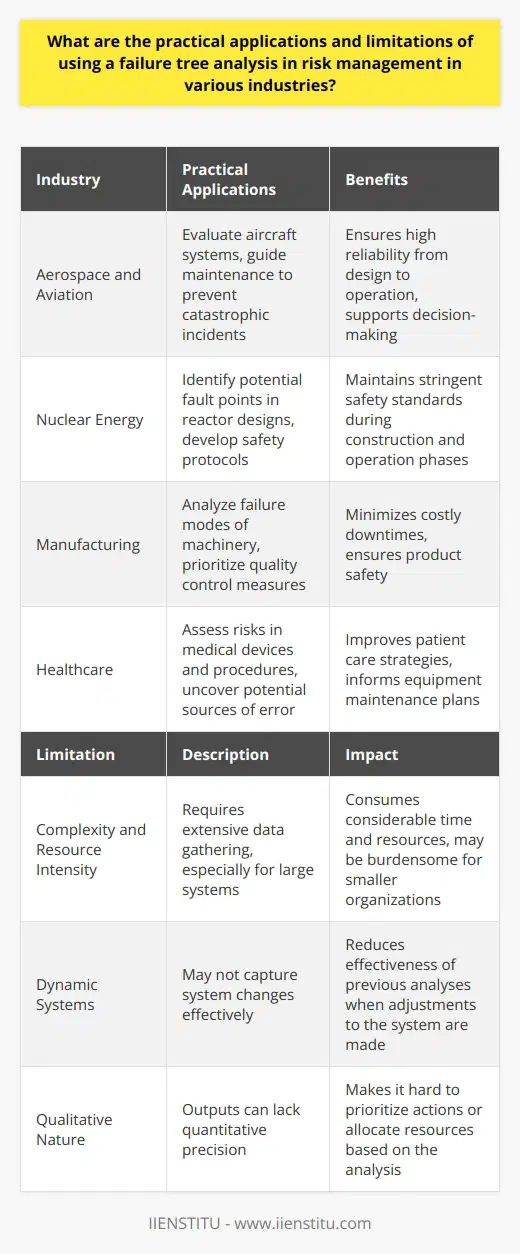
The careful examination of potential pitfalls in complex systems is a cornerstone of risk management and product reliability. One such method that stands at the forefront of evaluating and predicting system failures is Failure Tree Analysis (FTA). Initially conceived to bolster the safety protocols of aerospace endeavors, FTA has since burgeoned into an indispensable asset for myriad industries, providing a systematic approach for identifying the interplay of malfunctions leading to adverse events. The technique's inextricable link to the preservation of both apparatus integrity and human life cannot be understated. Adroitly woven into the fabric of various operational protocols, FTA serves as a sentinel, shielding stakeholders from the caprices of technological unpredictability.
Understanding Failure Tree Analysis
Concept of FTA
FTA's genesis can be traced back to the burgeoning era of space exploration, where the exigencies of safety were paramount. Originating within the defense industry to screen out potential system failures, it evolved, becoming more sophisticated with time. At its core, Failure Tree Analysis purveys a graphical representation of the pathways leading to a system failure, dissecting the sequence of faults to their most rudimentary origins. This method engenders an exhaustive analysis, where each constituent of a mechanism is scrutinized for its potential to precipitate a larger system failure.
Fundamental principles of FTA
Central to FTA's utility is the structural hierarchy it establishes. At the apogee of a Failure Tree lies the dreaded occurrence known as the top event, descending from which is a cascade of contributing mishaps, delineated as either root events or basic events, depending on their position within the tree. Tethering these nodes of malfunction together are the logical inferences, ostensibly gatekeepers that codify the conditions under which a failure transpires. It's these gates, denoting conjunctions and disjunctions within failure propagation, that sculpt the Failure Tree into a tool of perspicacity, illuminating pathways of doom with mathematical precision.
The role of logic gates in the construction of Failure Tree
Logic gates are the sinews that connect the skeletal form of a Failure Tree; they exemplify the underlying logical relationships incumbent to a system's operational folio. Gates such as AND and OR manifest the interdependencies within a system's architecture, transforming abstract notions of failure into a quantifiable and qualifiable analysis. Their judicious implementation makes all the difference, metamorphosing a mere diagram into a sagacious tutor that educators and engineers alike can consult with.
The process of conducting a Failure Tree Analysis
Identifying the top event
Visual Management: A Comprehensive Approach to Effective Communication
5S Methodology: A Comprehensive Guide for Process Optimization in Businesses
At the apex of every Failure Tree stands the top event—oftentimes a dreaded outcome whose avoidance is the raison d'être for the entire scrutiny. It is imperative to select an event that is consequential yet comprehensive, an encapsulation of a system's frailties and the beacon that lights up the rest of the analysis. Zeroing in on the correct top event mandates a confluence of expert knowledge alongside an intimate understanding of system operations.
Identification of lower-level events
Beneath the top event lies the hierarchy of woes, branching out like tributaries from a river. Categorizing these events is an exercise in precision; misclassify, and the entire analysis may falter. It involves tracing the lineage of each failure, discerning its origins—whether material defect, human error, or design oversights—and documenting them methodically. The efficacy of the FTA hinges on the meticulous identification of these underlying events.
Construction of the Failure Tree
Countenanced with the array of potential failings, one must painstakingly construct the Failure Tree, interweaving the strands of information with logical rigor. This ensemble begins with laying out the identified basic events, progressing towards amalgamating them using the vitally chosen logic gates.
How To Unlock Problem Solving Skills And Make Better Decisions
Mastering The 5 Whys Technique For Profound Problem-solving İnsights
Protocols during construction are exacting; one misstep, one faulty link in the chain of causality, can obfuscate rather than clarify potential risks.
Importance of Failure Tree Analysis
Significance in proactive risk management
Primum non nocere—the primal edict of 'do no harm'—resonates profoundly when considering the import of FTA in preempting risk. By elucidating the modes of failure that could bedevil a system, FTA serves as the avant-garde of proactive risk management. Its prominence in design safety and reliability disciplines ensures that vulnerability assessments precede, rather than react to, adverse outcomes, cementing FTA's status as an invaluable prophylactic against potential catastrophes.
Use in diverse industries
The footprints of FTA are etched across various industries, proving its flexibility and critical significance. Manufacturing management utilizes FTA to enhance product reliability and safeguard against production deficits. In service industries, its application underpins contingency planning; delineating failure modes protects both the provider and the recipient. The adaptability of FTA across sectors showcases its robustness as a tool for maintaining standard operational efficiency and customer satisfaction.
Case Studies of Failure Tree Analysis
Case Study 1: Application of FTA in the Aviation industry
In the aviation sector, where the cost of failure may invariably count in human lives, FTA's role is pivotal. When aircraft manufacturers enlist FTA, they disentangle complex systems to preempt mechanical and software failures that could lead to disastrous outcomes. Through distinguishing probable causes of malfunctions—from engine component failures to avionics glitches—FTA acts as a sentinel, overseeing the sanctity of air travel.
Case Study 2: Usage of FTA in Information Technology security risk management
In an era where digital infrastructures are integral to societal function, the assurance of information security is of paramount importance. An online certificate course may capture theoretical knowledge, but FTA transcribes theory into practice, particularly within IT risk management. Employing FTA allows cybersecurity professionals to simulate breaches, understanding and fortifying against vulnerabilities in a manner that is both profound and preemptive.
Challenges and Limitations of Failure Tree Analysis
Unique challenges in conducting FTA
While FTA is commendable for its efficacy, conducting a sound analysis is fraught with challenges. It demands a confluence of domain expertise and analytical skill, a diligence in discerning the connections between failures that may not be self-evident. The logistics of collating comprehensive data to support the analysis oftentimes constitute a formidable hurdle.
Limitations and criticisms of the FTA approach
Despite its merits, the FTA methodology is not devoid of criticisms. Detractors assert that the processes can be overly complex, time-consuming, and at times, reliant on subjective judgments, particularly in identifying and prioritizing potential failures. The deterministic nature of FTA has been questioned too; in reality, systems may harbor stochastic behaviors that elude FTA's conventional logic patterns.
The intricate dance of factors leading to a system's failure or success can captivatingly be choreographed via problem solving certification methodologies, entailing the prowess of Failure Tree Analysis. This article has delineated the layers that constitute FTA, revealing both its invaluable benefits in preemptive risk mitigation and the perils accompanying its misuse. Reflecting on FTA's contributions across industries, one cannot help but marvel at the potential for further refinement, beckoning continued research and technological advancements.
As engineers and analysts wield this analytical scythe, their explorations will dictate the future narrative of FTA, inscribing it either as an enduring lexicon of safety or a testament to the evolution of risk assessment methodologies.
Frequently Asked Questions
What are the fundamental principles and steps involved in conducting a failure tree analysis for risk assessment?
Understanding Failure Tree Analysis
Failure Tree Analysis (FTA) is a top-down approach. It assesses risk in complex systems. Experts widely use it across industries. It focuses on identifying root causes of system failures. The aim is to enhance reliability and safety.
Principles of FTA
Systematic examination lies at FTA's core. It operates on a premise that systems fail in predictable ways. Each failure stems from component level issues. These cascade upwards, affecting the whole system.
The principle of redundancy is also important. It suggests that multiple pathways can lead to failure. Thus, understanding and mitigating these pathways enhances system resilience.
Probabilistic risk assessment underpins FTA. It quantifies the likelihood of different failure modes. This allows prioritization of mitigating actions.
Steps in Conducting FTA
Step 1: Define the system.
Detail system components and interactions. Know the scope of your analysis.
Step 2: Identify possible failures.
List all potential failure modes. Think of what could go wrong.
Step 3: Construct the failure tree.
Start with a top event, often a critical failure. Work backwards to identify contributing events. Use logic symbols to represent these relationships.
Step 4: Gather data and information.
Collect information on failure rates and probabilities. Use historical data, expert opinion, and technical analysis.
Step 5: Analyze the failure tree.
Evaluate paths that lead to the top event. Determine critical paths that need attention.
Step 6: Calculate probabilities.
Quantify the likelihood of the top event. Combine individual failure probabilities. Use statistical methods for accuracy.
Step 7: Prioritize risks.
Focus on the most probable or impactful failures. Be practical in resource allocation.
Step 8: Develop mitigation strategies.
Formulate actions to reduce or eliminate risks. Plan for both short-term fixes and long-term solutions.
Step 9: Implement changes.
Apply the mitigation strategies. Ensure they integrate well with the system.
Step 10: Monitor and review.
Keep track of system performance. Update the failure tree as needed.
Key Takeaways
FTA is a structured approach. It requires meticulous planning and execution. A clear understanding of system behavior is crucial. As is attention to data quality and logic in analysis.
In essence, FTA serves to enhance, not just evaluate, system robustness. It informs decision-making and risk management. It is also a living process. Systems and their risks evolve, and so should the FTA.
Acting on FTA findings promotes safety and reliability. It prepares systems to withstand and recover from failures. It is a vital tool for engineers and risk managers alike.

How does failure tree analysis assist in identifying potential failures in a system or process?
What is Failure Tree Analysis?
Failure Tree Analysis (FTA) is a deductive tool. It helps in understanding system reliability and safety. Engineers and analysts use FTA extensively. It is particularly useful for complex systems. It uncovers potential failures before they occur.
Roles in Identifying Potential Failures
FTA serves a crucial role in failure identification. Below, we explore its functions in various ways.
Systematic Breakdown
FTA starts with a top-level event. This event is typically the undesired state you wish to analyze. The tree breaks this event into lower-level events. These are the basic causes that might lead to it. By starting at the top and working down, FTA ensures a thorough analysis.
Logical Relationships
Through logic symbols, FTA illustrates how failures connect. These symbols represent AND and OR gates. They guide analysts to see how various factors might combine. This helps pinpoint how failures might occur.
Identification of Root Causes
Finding root causes is pivotal. FTA aids in tracing back from potential failure to its source. This makes it easier to weed out the real issues. When you know the root causes, you can take proactive measures.
Quantitative Analysis
FTA can also be quantitative. It uses probabilities to determine the likelihood of failures. These probabilities help assess the impact of individual components. They thereby inform risk management decisions.
Prioritizing Corrective Actions
Understanding failure pathways aids in prioritizing actions. Analysts can focus on high-risk areas. They allocate resources where they are most needed.
Enhancing System Reliability
Reliability gets a boost through FTA. By addressing potential failures, systems become more robust. FTA can lead to design improvements. It thereby enhances overall system performance.
Advantages of Failure Tree Analysis
- Systematic Approach: FTA is methodical. It leaves little room for oversight.
- Visual Representation: It provides a clear diagram. This represents how failures spread through a system.
- Multidisciplinary Use: FTA suits various industries. Its principles apply across many fields.
- Diagnosing Interrelated Failures: FTA can show how failures in different parts of a system may affect each other.
- Proactive Risk Reduction: It shines in proactive risk management. This prevents problems before they escalate.
Conclusion
FTA is a strong tool for failure identification. It structures the process of diagnosing system flaws. FTA's logic-driven approach yields a comprehensive examination of potential problems. This aids experts in crafting more reliable and safer systems. Its application ranges from the aerospace to the medical industry. As such, FTA remains a cornerstone in failure analysis practices.

What are the practical applications and limitations of using a failure tree analysis in risk management in various industries?
Practical Applications of Failure Tree Analysis
Failure Tree Analysis (FTA) is a robust technique. Organizations across industries use it. They aim to assess and mitigate risks. FTA identifies root causes of failures. It does so by breaking down complex systems. Engineers and safety professionals often employ FTA. Thus, it finds applications in several fields.
Aerospace and Aviation
In these sectors, safety is non-negotiable. FTA helps understand what might fail. Reliability engineers use it to evaluate aircraft systems. Maintenance teams do too. They work to prevent catastrophic incidents. As such, FTA guides decision-making. It ensures high reliability from design to operation.
Nuclear Energy
Here, the cost of failure is immense. FTA becomes indispensable. It identifies potential fault points in reactor designs. Safety protocols derive from its outputs. FTA processes oversee both the construction and the operation phases. As a result, nuclear facilities maintain stringent safety standards.
Manufacturing Industry
The method reduces production risks. It does so by analyzing failure modes of machinery. Manufacturers prioritize FTA in quality control measures. They also apply it in the design and testing of products. Such analysis minimizes costly downtimes. It also ensures product safety.
Healthcare
Patient safety is paramount. FTA assesses risks in medical devices and procedures. It uncovers potential sources of error. Healthcare workers rely on the insights. They improve patient care strategies. FTA also informs equipment maintenance plans.
Limitations of Failure Tree Analysis
Despite its benefits, FTA has limitations. Knowing these is critical to apply the technique effectively.
Complexity and Resource Intensity
FTA can be complex. It requires extensive data gathering. Large systems pose a challenge. The process consumes considerable time and resources. Smaller organizations may find it burdensome.
Dynamic Systems
Systems often change. FTA may not capture such dynamics well. Adjustments to the system necessitate new analyses. This may reduce the effectiveness of previous FTAs.
Qualitative Nature
FTA outputs can be qualitative. They might lack quantitative precision. This can make it hard to prioritize actions. Or to allocate resources based on the analysis.
Overlooking Human Error
Failures are not always technical. Human error plays a role. Traditional FTA might not fully account for this. It may focus too much on hardware or software failures.
Unanticipated Events
FTA depends on foreseeable faults. Surprise events may not show up in analyses. Such events can still cause significant failures. FTA might give a false sense of security in such cases.
Conclusion
Failure Tree Analysis is a powerful tool. It carries significant merit in risk management. Industries benefit from its systematic approach. However, awareness of its limitations is crucial. Proper use demands a complementary suite of risk assessment tools. Together, they strengthen industry safety and reliability measures.



